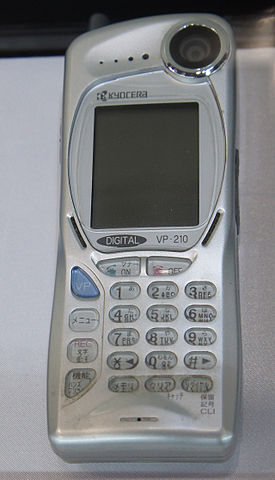World First Camera Phone The Kyocera VP-210
 Just did our bit for history: the 1st ever cameraphone was actually made by Kyocera, and designed for selfies! http://bit.ly/1pnube3
Just did our bit for history: the 1st ever cameraphone was actually made by Kyocera, and designed for selfies! http://bit.ly/1pnube3
Camera-phones.. a legend born in Japan, widely believed first commercial launch usually noted is the J-SH04, with other claims on an earlier release from Samsung. However we took a moment to correct that Wikipedia page pointing to the actual World First cameraphone Kyocera VP-210 Visual Phone. [Eds]
 The Kyocera VP-210
The Kyocera VP-210
Kyocera Corporation, an electronics manufacturer based in Kyoto, conducted a two year development campaign from 1997 to 1999 that resulted in the release of the VP-210 VisualPhone, the world’s first mobile colour videophone that also doubled as a camera phone for still photos. The camera phone was the same size as similar contemporary mobile phones, but sported a large camera lens and a 5 cm (2 inch) colour TFT display capable of displaying 65,000 colors, and was able to process two video frames per second. The 155 gram (5.5 oz.) camera could also take 20 photos and convey them by e-mail, with the camera phone retailing at the time for 40,000 yen, about US$325 in 1999.
The VP-210 was released in May 1999 and used its single front-facing 110,000-pixel camera to send two images per second through Japan’s PHS mobile phone network system. Although its frame rate was crude and its memory is considered tiny in the present day, the phone was viewed as “revolutionary” at the time of its release.
The Kyocera project was initiated at their Yokohama research and development center by Kazumi Saburi, one of their section managers. His explanation for the project was “Around that time, cellular handsets with enabled voice and SMS communication capabilities were considered to be just one among many personal communication tools. One day a simple idea hit us – ‘What if we were able to enjoy talking with the intended person watching his/her face on the display?’ We were certain that such a device would make cell phone communications much more convenient and enjoyable.”
Saburi also stated that their R&D section had “nourished [the idea] for several years before” they received project approval from their top management which had encourage such forward-thinking research, because they “also believed that such a product would improve Kyocera’s brand image.” Their research showed that a “cell phone with a camera and color display provided a completely new value for users, It could be used as a phone, a camera and a photo album”. Technical challenges handled by about a dozen engineers at Kyocera over the two year development period included the camera module’s placement within the phone at a time when electronic components had not been fully reduced in size, as well as increasing its data transmission rate.

